ABS BUICK REGAL 1996 Owners Manual
[x] Cancel search | Manufacturer: BUICK, Model Year: 1996, Model line: REGAL, Model: BUICK REGAL 1996Pages: 356, PDF Size: 17.97 MB
Page 158 of 356

Avoid needless heavy braking. Some people drive in
spurts
-- heavy acceleration followed by heavy
braking
-- rather than keeping pace with traffic. This is a
mistake. Your brakes may not have time to cool between
hard stops. Your brakes will wear
out much faster if you
do
a lot of heavy bralung. If you keep pace with the
traffic and allow realistic following distances, you will
eliminate
a lot of unnecessary braking. That means
better braking and longer brake life.
If your engine ever stops while you’re driving, brake
normally but don’t pump your brakes. If you do, the
pedal may get harder to push down.
If your engine
stops, you will still have some power brake assist. But
you will use it when you brake. Once the power assist is
used up, it may take longer to
stop and the brake pedal
will be harder
to push.
Anti-Lock Brakes
Your vehicle has anti-lock brakes (ABS). ABS is an
advanced electronic braking system that will help
prevent
a braking skid.
When you start your engine, or when you begin to drive
away, your anti-lock brake system
will check itself. You
may hear a momentary motor or clicking noise while
this test is going on, and you may even notice that your
brake pedal moves a little. This is normal.
If there’s a problem
with the
anti-lock brake system, this warning light will stay
on
or flash. See “Anti-Lock
Brake System Warning
Light” in the Index.
ProCarManuals.com
Page 159 of 356
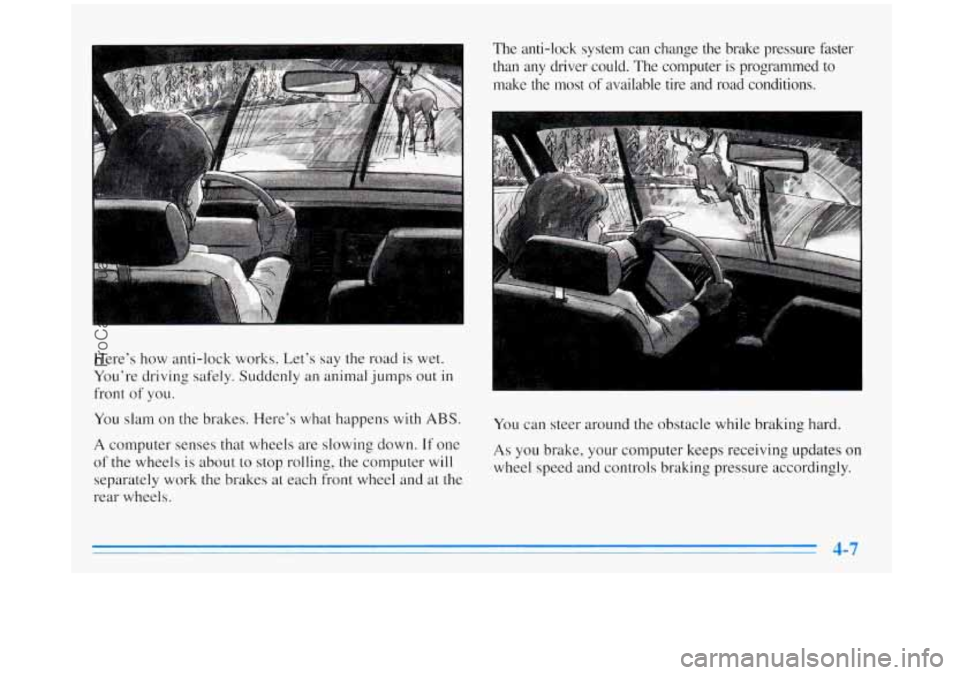
Here’s how anti-lock works. Let’s say the road is wet.
You’re driving safely. Suddenly an animal jumps
out in
front
of you.
You slam on the brakes. Here’s what happens with ABS.
A computer senses that wheels are slowing down. If one
of the wheels is about to stop rolling, the computer will
separately work the brakes at each front wheel and at the
rear wheels. The
anti-lock system can change the brake pressure faster
than any driver could.
The computer is programmed to
make the most
of available tire and road conditions.
I
You can steer around the obstacle while braking hard.
As you brake, your computer keeps receiving updates on
wheel speed and controls braking pressure accordingly.
ProCarManuals.com
Page 165 of 356
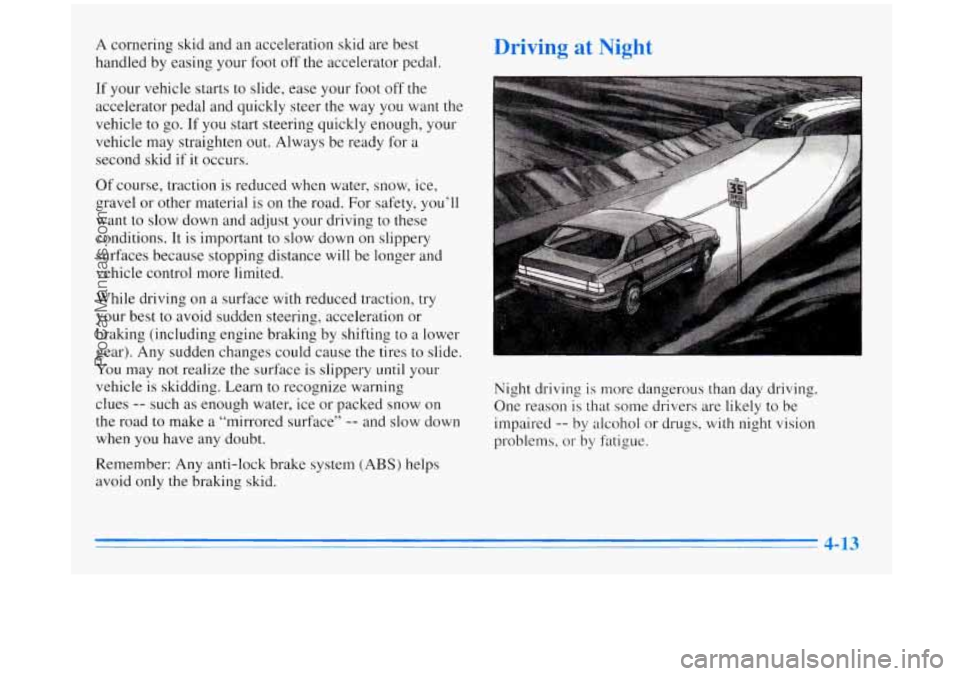
A cornering skid and an acceleration skid are best
handled by easing your foot off the accelerator pedal.
If your vehicle starts to slide, ease your foot
off the
accelerator pedal and quickly steer the way you want the
vehicle to go.
If you start steering quickly enough, your
vehicle may straighten out. Always be ready for a
second skid if it occurs.
Of course, traction
is reduced when water, snow, ice,
gravel or other material is on the road.
For safety, you’ll
want to slow down and adjust your driving to these
conditions.
It is important to slow down on slippery
surfaces because stopping distance will be longer and
vehicle control more limited.
While driving on
a surface with reduced traction, try
your best to avoid sudden steering, acceleration or
braking (including engine braking
by shifting to a lower
gear). Any sudden changes could cause the tires
to slide.
You may not realize the surface is slippery until your
vehicle is skidding. Learn to recognize warning
clues
-- such as enough water, ice or packed snow on
the road to make
a “mirrored surface” -- and slow down
when you have any doubt.
Remember: Any anti-lock brake system
(ABS) helps
avoid only
the braking skid.
DrivinP at Night
Night driving is more dangerous than day driving.
One reason
is that some drivers are likely to be
impaired
-- by alcohol or drugs, with night vision
problems, or by fatigue.
ProCarManuals.com
Page 187 of 356
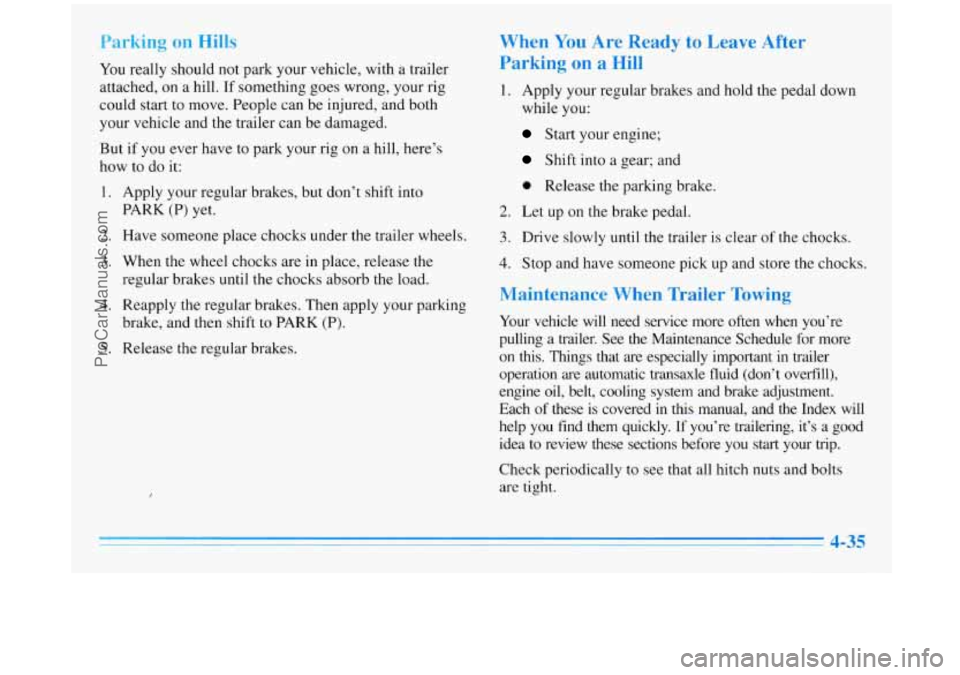
Parking on Hills
You really should not park your vehicle, with a trailer
attached, on a hill.
If something goes wrong, your rig
could start to move. People can be injured, and both
your vehicle and the trailer can be damaged.
But if you ever have to park your rig
on a hill, here’s
how
to do it:
1. Apply your regular brakes, but don’t shift into
PARK (P)
yet.
2. Have someone place chocks under the trailer wheels.
3. When the wheel chocks are in place, release the
regular brakes until
the chocks absorb the load.
4. Reapply the regular brakes. Then apply your parking
brake, and then shift
to PARK (P).
5. Release the regular brakes.
When You Are Ready to Leave After
Parking on a Hill
1. Apply your regular brakes and hold the pedal down
while you:
Start your engine;
Shift into a gear; and
0 Release the parking brake.
2. Let up on the brake pedal.
3. Drive slowly until the trailer is clear of the chocks.
4. Stop and have someone pick up and store the chocks.
Maintenance When Trailer Towing
Your vehicle will need service more often when you’re
pulling a trailer. See the Maintenance Schedule for more
on this. Things that are especially important in trailer
operation are automatic transaxle
fluid (don’t overfill),
engine oil, belt, cooling system and brake adjustment.
Each of these is covered in this manual, and the Index will
help you find them quickly. If you’re trailering, it’s a good
idea to review these sections before you start your trip.
Check periodically to see that all hitch nuts and bolts
are tight.
4-35
ProCarManuals.com
Page 254 of 356
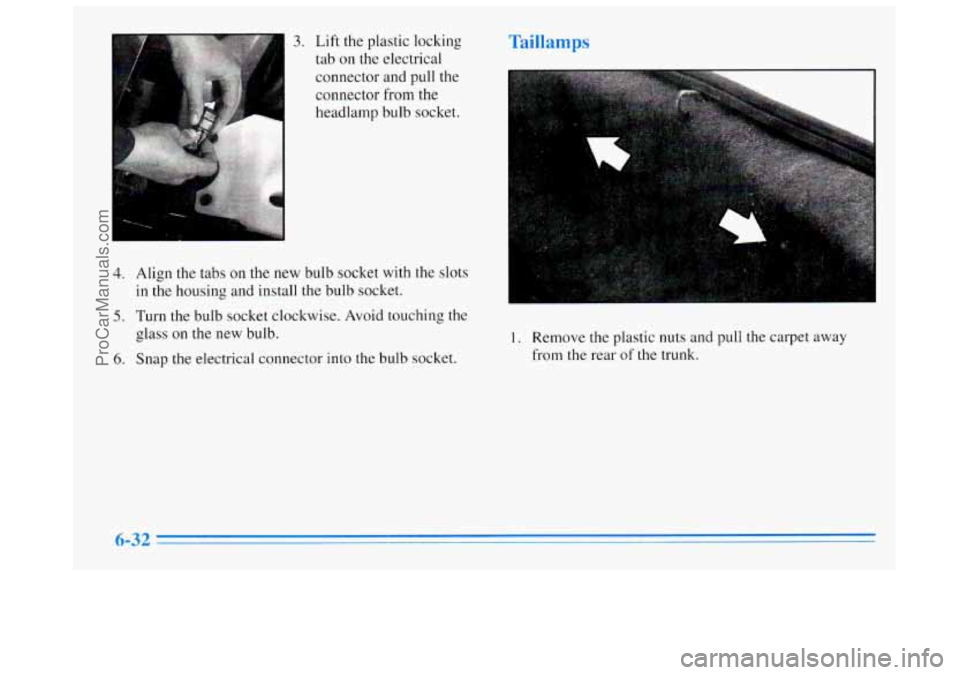
3. Lift the plastic locking
tab on the electrical
connector and pull the
connector from the
headlamp bulb socket.
4. Align the tabs on the new bulb socket with the slots
5. Turn the bulb socket clockwise. Avoid touching the
in the housing and install the bulb socket.
glass
on the new bulb.
6. Snap the electrical connector into the bulb socket.
1. Remove the plastic nuts and pull the carpet away
from the rear of the trunk.
ProCarManuals.com
Page 272 of 356
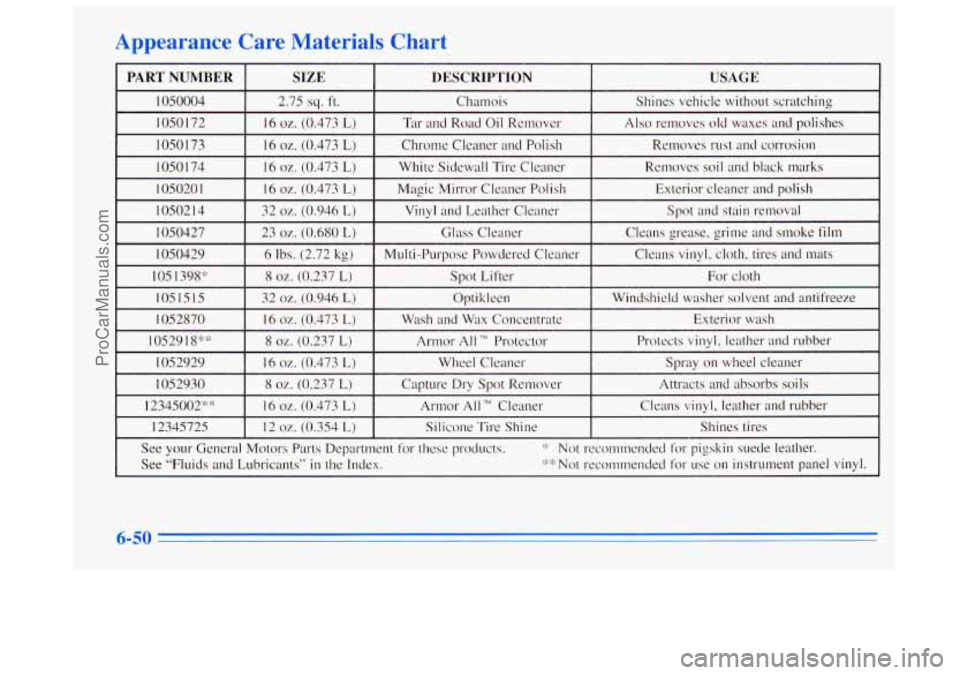
Appearance Care Materials Chart
PART NUMBER USAGE DESCRIPTION
SIZE
1050004
Also removes old waxes and polishes Tar and Road Oil
Remover
16 oz. (0.473 L) I 050 172 Shines
vehicle without scratching Chamois
2.75
sq. ft.
~~~
1050173 16 oz. (0.473 Lj Chrome Cleaner and Polish
Removes soil
and black marks
White Sidewall Tire Cleaner 16 oz. (0.473 L) 1050174 Removes
rust
and corrosion
~~~ ~ ~~~~~~~~~~~ ~~~ ~ ~ ~
105020 I
Windshield washer solvent and antifreeze
Optikleen
32 oz. (0.946 L) 1051515
For
cloth
Spot Lifter 8 oz. (0.237 L) 105 1398* Cleans
vinyl, cloth,
tires and mats
Multi-Purpose Powdered Cleaner 6 lbs. (2.72 kg)
1050429 Cleans grease, grime
and smoke film
Glass Cleaner 23
oz. (0.680 L) 1050427 Spot
and stain removal
Vinyl and Leather Cleaner
32 02. (0.946 L)
IO502 14 Exterior
cleaner and
polish Magic Mirror Cleaner Polish 16 OZ. (0.473 Lj
I 1 OS2870 I 16 oz. (0.473 L) I Wash and Wax Concentrate I Exterior wash
10529
18** Protects vinyl, leather and rubber
Armor All TM Protector 8 oz. (0.237 L)
1052929
Cleans
vinyl, leather and rubber
Armor All TM Cleaner 16 oz. (0.473 L) 12345002** Attracts and absorbs soils
Capture Dry Spot Remover
8 oz. (0.237 L) 1052930 Spray
on wheel
cleaner
Wheel Cleaner
16 oz. (0.473 L)
12345725 Shines tires
Silicone Tire Shine
12
oz. (0.354 L)
See your General Motors Parts Department for these products. :j: Not recommended for pigskin suede leather.
See "Fluids and Lubricants''
in the Index. :t::f: Not recommended for use on instrument panel vinyl.
6-50
ProCarManuals.com
Page 276 of 356
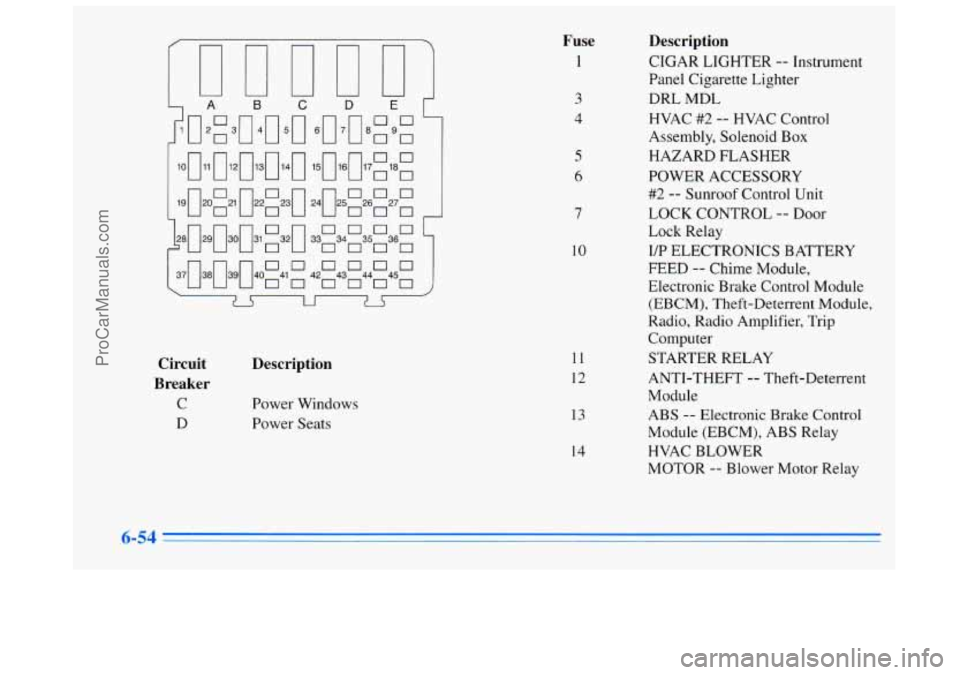
Circuit
Breaker
C
D
Description
Power Windows
Power Seats
Fuse
1
3
4
5
6
7
10
11
12
13
14
Description
CIGAR LIGHTER -- Instrument
Panel Cigarette Lighter
DRL MDL
HVAC
#2 -- HVAC Control
Assembly, Solenoid Box
HAZARD FLASHER
POWER ACCESSORY
#2 -- Sunroof Control Unit
LOCK CONTROL
-- Door
Lock Relay
I/P ELECTRONICS BATTERY
FEED
-- Chime Module,
Electronic Brake Control Module
(EBCM), Theft-Deterrent Module,
Radio, Radio Amplifier, Trip
Computer
STARTER RELAY
ANTI-THEFT
-- Theft-Deterrent
Module
ABS
-- Electronic Brake Control
Module (EBCM), ABS Relay
HVAC
BLOWER
MOTOR -- Blower Motor Relay
ProCarManuals.com
Page 280 of 356

Und ’ hood Elect
Additional fuses are in the underhood electrical center
on the driver’s side
of the engine compartment.
DDD FOG LPS PARKLPS HORN
Fuse
PARK LPS
HORN
VAR P/S
ABS
Description
Headlamp Switch
Horn Relay, Underhood Lamp
EVO Steering
Anti-Lock Brake System
6-58
ProCarManuals.com
Page 281 of 356
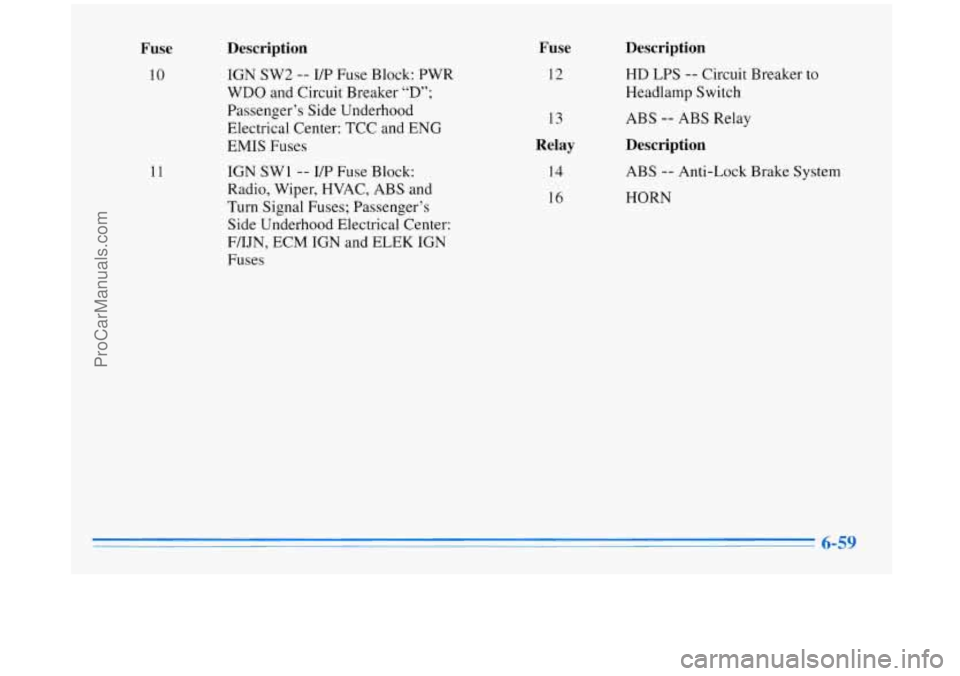
Fuse
10
11
Description
IGN SW2 -- I/P Fuse Block: PWR
WDO and Circuit Breaker
“D”;
Passenger’s Side Underhood
Electrical Center: TCC and ENG
EMIS Fuses
IGN SW1
-- I/P Fuse Block:
Radio, Wiper, HVAC, ABS and
Turn Signal Fuses; Passenger’s
Side Underhood Electrical Center:
F/IJN,
ECM IGN and ELEK IGN
Fuses
Fuse
12
13
Relay
14
16
Description
HD LPS -- Circuit Breaker to
Headlamp Switch
ABS
-- ABS Relay
Description
ABS -- Anti-Lock Brake System
HORN
6-59
ProCarManuals.com